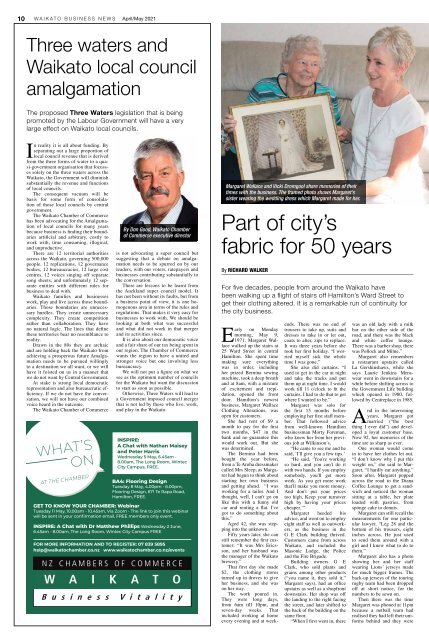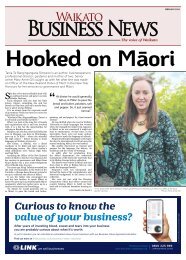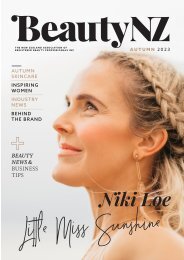Waikato Business News April/May 2021
Waikato Business News has for a quarter of a century been the voice of the region’s business community, a business community with a very real commitment to innovation and an ethos of co-operation.
Waikato Business News has for a quarter of a century been the voice of the region’s business community, a business community with a very real commitment to innovation and an ethos of co-operation.
You also want an ePaper? Increase the reach of your titles
YUMPU automatically turns print PDFs into web optimized ePapers that Google loves.
10 WAIKATO BUSINESS NEWS <strong>April</strong>/<strong>May</strong> <strong>2021</strong><br />
Three waters and<br />
<strong>Waikato</strong> local council<br />
amalgamation<br />
The proposed Three Waters legislation that is being<br />
promoted by the Labour Government will have a very<br />
large effect on <strong>Waikato</strong> local councils.<br />
In reality it is all about funding. By<br />
separating out a large proportion of<br />
local council revenue that is derived<br />
from the three forms of water to a quasi-government<br />
organisation that focusses<br />
solely on the three waters across the<br />
<strong>Waikato</strong>, the Government will diminish<br />
substantially the revenue and functions<br />
of local councils.<br />
The consequent vacuum will be<br />
basis for some form of consolidation<br />
of those local councils by central<br />
government.<br />
The <strong>Waikato</strong> Chamber of Commerce<br />
has been advocating for the Amalgamation<br />
of local councils for many years<br />
because business is finding their boundaries<br />
artificial and arbitrary, costly to<br />
work with, time consuming, illogical,<br />
and unproductive.<br />
There are 12 territorial authorities<br />
across the <strong>Waikato</strong>, governing 500,000<br />
people. 12 replications, 12 governance<br />
bodies, 12 bureaucracies, 12 large cost<br />
centres, 12 voices singing off separate<br />
song sheets, and unfortunately 12 separate<br />
entities with different rules for<br />
business to deal with.<br />
<strong>Waikato</strong> families and businesses<br />
work, play and live across those boundaries.<br />
Those boundaries are unnecessary<br />
hurdles. They create unnecessary<br />
complexity. They create competition<br />
rather than collaboration. They have<br />
no natural logic. The lines that define<br />
these territories bear no resemblance to<br />
reality.<br />
Drawn in the 80s they are archaic<br />
and are holding back the <strong>Waikato</strong> from<br />
achieving a prosperous future Amalgamation<br />
needs to be pursued willingly<br />
to a destination we all want, or we will<br />
have it foisted on us in a manner that<br />
we do not want by Central Government.<br />
At stake is strong local democratic<br />
representation and also bureaucratic efficiency.<br />
If we do not have the conversation,<br />
we will not have our combined<br />
voice heard in the outcome.<br />
The <strong>Waikato</strong> Chamber of Commerce<br />
By Don Good, <strong>Waikato</strong> Chamber<br />
of Commerce executive director<br />
is not advocating a super council but<br />
suggesting that a debate on amalgamation<br />
needs to be spurred on by our<br />
leaders, with our voters, ratepayers and<br />
businesses contributing substantially to<br />
the conversation.<br />
There are lessons to be learnt from<br />
the Auckland super council model. It<br />
has not been without its faults, but from<br />
a business point of view, it is one homogenous<br />
area in terms of the rules and<br />
regulations. That makes it very easy for<br />
businesses to work with. We should be<br />
looking at both what was successful<br />
and what did not work in that merger<br />
and its activities since.<br />
It is also about our democratic voice<br />
and a fair share of our tax being spent in<br />
our region. The Chamber of Commerce<br />
wants the region to have a united and<br />
stronger voice but one involving less<br />
bureaucracy.<br />
We will not put a figure on what we<br />
see as the optimum number of councils<br />
for the <strong>Waikato</strong> but want the discussion<br />
to start as soon as possible.<br />
Otherwise, Three Waters will lead to<br />
a Government imposed council merger<br />
that is not led by those who live, work,<br />
and play in the <strong>Waikato</strong>.<br />
Margaret Wallace and Vicki Dromgool share memories of their<br />
times with the business. The framed photo shows Margaret’s<br />
sister wearing the wedding dress which Margaret made for her.<br />
Part of city’s<br />
fabric for 50 years<br />
By RICHARD WALKER<br />
For five decades, people from around the <strong>Waikato</strong> have<br />
been walking up a flight of stairs off Hamilton’s Ward Street to<br />
get their clothing altered. It is a remarkable run of continuity for<br />
the city business.<br />
Early on Monday<br />
morning, <strong>May</strong> 9,<br />
1971, Margaret Wallace<br />
walked up the stairs at<br />
25 Ward Street in central<br />
Hamilton. She spent time<br />
making sure everything<br />
was in order, including<br />
her prized Bernina sewing<br />
machine, took a deep breath<br />
and at 8am, with a mixture<br />
of excitement and trepidation,<br />
opened the front<br />
door. Hamilton’s newest<br />
business, Margaret Wallace<br />
Clothing Alterations, was<br />
open for customers.<br />
She had rent of $9 a<br />
month to pay for the first<br />
two months, $47 in the<br />
bank and no guarantee this<br />
would work out. But she<br />
was determined.<br />
The Bernina had been<br />
bought the year before,<br />
from a Te Aroha dressmaker<br />
called Mrs Sleep, as Margaret<br />
had begun to think about<br />
starting her own business<br />
and getting ahead. “I was<br />
working for a tailor. And I<br />
thought, well, I can't go on<br />
like this with a funny old<br />
car and renting a flat. I've<br />
got to do something about<br />
this.”<br />
Aged 42, she was stepping<br />
into the unknown.<br />
Fifty years later, she can<br />
still remember the first customer:<br />
“It was Mrs Ericsson,<br />
and her husband was<br />
the manager of the <strong>Waikato</strong><br />
brewery.”<br />
That first day she made<br />
$2, the clothing stores<br />
turned up in droves to give<br />
her business, and she was<br />
on her way.<br />
The work poured in.<br />
They were long days,<br />
from 6am till 10pm, and<br />
seven-day weeks. That<br />
included working at home<br />
every evening and at weekends.<br />
There was no end of<br />
trousers to take up, suits and<br />
dresses to take in or let out,<br />
coats to alter, zips to replace.<br />
It was three years before she<br />
took her first holiday. “I worried<br />
myself sick the whole<br />
time I was gone.”<br />
She also did curtains. “I<br />
used to get in the car at night<br />
and take the tracks and put<br />
them up at night time. I would<br />
work till 11 o'clock to fit the<br />
curtains. I had to do that to get<br />
where I wanted to be.”<br />
Margaret was solo for<br />
the first 15 months before<br />
employing her first staff member.<br />
That followed advice<br />
from well-known Hamilton<br />
businessman Morty Foreman,<br />
who knew her from her previous<br />
job at Wilkinson’s.<br />
“He came to see me and he<br />
said, ‘I'll give you a few tips.’<br />
“He said, ‘You're working<br />
so hard, and you can't do it<br />
with two hands. If you employ<br />
somebody, you'll get more<br />
work. As you get more work<br />
that'll make you more money.<br />
And don't put your prices<br />
too high. Keep your turnover<br />
high by having your prices<br />
cheaper.’”<br />
Margaret heeded his<br />
advice, and went on to employ<br />
eight staff as well as outworkers,<br />
as the business in the<br />
G E Clark building thrived.<br />
Customers came from across<br />
<strong>Waikato</strong>, and included the<br />
Masonic Lodge, the Police<br />
and the Fire Brigade.<br />
Building owners G E<br />
Clark, who sold plants and<br />
grains among other products<br />
(“you name it, they sold it,”<br />
Margaret says), had an office<br />
upstairs as well as a shopfront<br />
downstairs. Her shop was off<br />
the landing to the right facing<br />
the street, and later shifted to<br />
the back of the building on the<br />
same floor.<br />
“When I first went in, there<br />
was an old lady with a milk<br />
bar on the other side of the<br />
road, and there was the black<br />
and white coffee lounge.<br />
There was a barber shop, there<br />
was Pollock and Milne.”<br />
Margaret also remembers<br />
a restaurant upstairs called<br />
La Gershinshaws, while she<br />
says Laurie Jenkins Menswear<br />
went in downstairs for a<br />
while before shifting across to<br />
the Government Life building<br />
which opened in 1980, followed<br />
by Centreplace in 1985.<br />
And in the intervening<br />
years, Margaret got<br />
married (“the best<br />
thing I ever did”) and developed<br />
a loyal customer base.<br />
Now 92, her memories of the<br />
time are as sharp as ever.<br />
One woman would come<br />
in to have her clothes let out.<br />
“I don’t know why I put this<br />
weight on,” she said to Margaret,<br />
“I hardly eat anything.”<br />
Soon after, Margaret popped<br />
across the road to the Diana<br />
Coffee Lounge to get a sandwich<br />
and noticed the woman<br />
sitting at a table, her plate<br />
loaded with pastries, from<br />
sponge cake to donuts.<br />
Margaret can still recall the<br />
measurements for one particular<br />
lawyer. “Leg 28 and the<br />
bottom of his trousers, eight<br />
inches across. He just used<br />
to send them around with a<br />
girl and I knew what to do to<br />
them.”<br />
Margaret also has a photo<br />
showing her and her staff<br />
wearing Lions’ jerseys made<br />
for much bigger frames. The<br />
back-up jerseys of the touring<br />
rugby team had been dropped<br />
off at short notice, for the<br />
numbers to be sewn on.<br />
Then there was the time<br />
Margaret was phoned at 11pm<br />
because a netball team had<br />
realised they had left their uniforms<br />
behind and they were


















